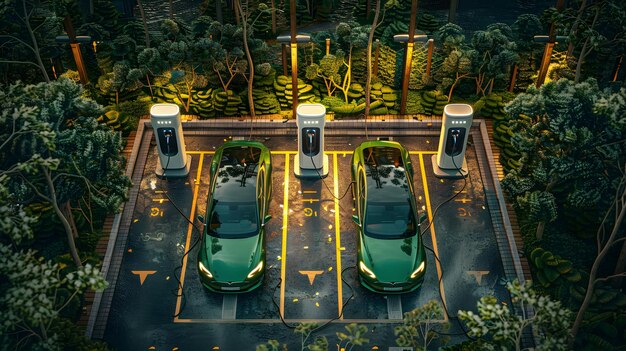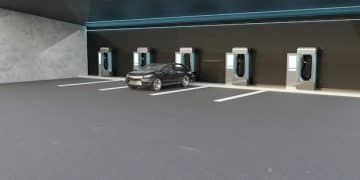Electric Vehicle Charging Infrastructure: 2024-2025 Growth Predictions

The latest predictions for the growth of the **electric vehicle charging infrastructure market in the US** indicate a significant expansion, driven by increasing EV adoption, government incentives, and technological advancements in charging solutions, with projections focusing on enhanced accessibility, faster charging speeds, and smart grid integration.
The shift towards electric vehicles (EVs) is reshaping the automotive landscape, and at the heart of this transformation lies the crucial infrastructure supporting these vehicles: the charging stations. Understanding **what are the latest predictions for the growth of the electric vehicle charging infrastructure market in the US** is essential for investors, policymakers, and consumers alike as we navigate this evolving sector.
Current State of EV Charging Infrastructure in the US
Before diving into the predictions, it’s important to understand the current state of the electric vehicle charging infrastructure in the US. The existing network is a mix of public and private charging stations, varying in charging speed and accessibility.
Currently, the EV charging landscape is segmented into three levels: Level 1, Level 2, and DC Fast Charging (also known as Level 3). Level 1 charging typically uses a standard 120V outlet, providing a slow charging speed suitable for overnight charging at home. Level 2 charging utilizes a 240V outlet, significantly reducing charging time. DC Fast Charging offers the quickest charging option, capable of adding significant range in a short period, making it ideal for highway travel and commercial use.
Key Players in the Charging Infrastructure Market
Several companies are actively involved in developing and deploying EV charging infrastructure across the US. These include:
- Tesla: Known for its Supercharger network, Tesla provides proprietary charging solutions exclusively for its vehicles, offering fast and reliable charging along major routes.
- ChargePoint: ChargePoint operates one of the largest open charging networks, offering both Level 2 and DC Fast Charging options. They cater to various customers, including businesses, municipalities, and individual EV owners.
- Electrify America: Backed by Volkswagen as part of its emissions settlement, Electrify America focuses on building a nationwide network of DC Fast Charging stations, targeting highway corridors and metropolitan areas.
These key players, alongside smaller companies and government initiatives, are driving the expansion of EV charging infrastructure to meet the growing demand from EV adoption.

The current infrastructure faces challenges such as uneven distribution of charging stations, particularly in rural areas, and concerns about charging speed and reliability. These factors are driving innovations and investments in the sector.
Understanding the existing infrastructure and its limitations sets the stage for exploring the future predictions for the growth of the market and the expected improvements and expansions.
Projected Growth Rate of the EV Charging Market
The electric vehicle charging infrastructure market is poised for substantial growth in the coming years. Several market research reports and industry analyses predict a significant increase in the number of charging stations and the overall market value.
Industry experts forecast a compound annual growth rate (CAGR) of over 30% for the EV charging infrastructure market in the US between 2024 and 2030. This growth is fueled by increasing EV sales, government incentives, and private investments in charging infrastructure. The market is expected to evolve from simply providing charging points to offering comprehensive charging solutions, including smart charging, energy management, and integration with renewable energy sources.
Factors Driving Market Growth
Multiple factors are contributing to the projected growth rate, including:
- Increasing EV Adoption: As more consumers and businesses switch to EVs, the demand for charging infrastructure will rise significantly.
- Government Incentives: Federal and state governments are offering tax credits, grants, and rebates to encourage the deployment of charging stations.
- Technological Advancements: Innovations in charging technology, such as faster charging speeds and wireless charging, are making EVs more convenient and appealing.
These factors are creating a favorable environment for the expansion of the EV charging infrastructure market, attracting investments and driving innovation.
The projected growth rate signifies a dynamic market landscape, with opportunities for businesses to capitalize on the increasing demand for EV charging solutions and contribute to the transition towards sustainable transportation.
Impact of Government Policies and Incentives
Government policies and incentives play a crucial role in accelerating the growth of the EV charging infrastructure market. Federal and state initiatives are designed to encourage the deployment of charging stations and support EV adoption.
The Bipartisan Infrastructure Law, signed into law in 2021, allocates billions of dollars to support the development of EV charging infrastructure across the US. This funding is intended to build a national network of charging stations, prioritizing underserved communities and rural areas. Additionally, the Inflation Reduction Act of 2022 extends and expands tax credits for EV purchases and charging infrastructure, making EVs more affordable and incentivizing the installation of charging stations.
State-Level Initiatives
In addition to federal programs, many states have implemented their own initiatives to promote EV adoption and charging infrastructure development. These include:
- California: California offers rebates for EV purchases and funding for charging station installations through programs like the California Electric Vehicle Infrastructure Project (CALeVIP).
- New York: New York provides tax credits for EV charging equipment and supports the development of charging infrastructure through the Charge Ready NY initiative.
- Texas: Texas offers grants for charging station installations and promotes EV adoption through the Texas Emissions Reduction Plan (TERP).
These policies and incentives are creating a supportive environment for the growth of the EV charging infrastructure market, attracting investments and accelerating the deployment of charging stations.
The availability of funding and incentives is a key driver of market growth, encouraging businesses and individuals to invest in EV charging infrastructure and contribute to the transition towards sustainable transportation.

Technological Advancements in Charging Solutions
Technological advancements are transforming the EV charging landscape, improving charging speeds, enhancing user experience, and enabling smart grid integration. These innovations are making EVs more convenient and appealing to consumers.
One of the key advancements is the development of faster charging technologies, such as Extreme Fast Charging (XFC), which can add significant range to an EV in a short period. XFC stations utilize higher voltage and current levels to deliver charging speeds of up to 350 kW, reducing charging time to as little as 15-30 minutes. Additionally, wireless charging technology is emerging as a convenient alternative to plug-in charging, allowing EVs to charge automatically when parked over a charging pad.
Smart Charging and Grid Integration
Other technological advancements focus on smart charging and grid integration, including:
- Smart Charging: Smart charging systems optimize charging schedules based on grid conditions and energy prices, reducing strain on the grid and lowering charging costs for EV owners.
- Vehicle-to-Grid (V2G) Technology: V2G technology allows EVs to send energy back to the grid during peak demand periods, providing grid stabilization and reducing the need for additional power plants.
- Renewable Energy Integration: Integrating EV charging with renewable energy sources, such as solar and wind power, reduces the carbon footprint of EV charging and supports the transition to a clean energy economy.
These technological advancements are enhancing the efficiency, reliability, and sustainability of EV charging infrastructure, making EVs a more attractive option for consumers and businesses.
The ongoing innovations in charging solutions are expected to drive further growth in the EV charging market, creating new opportunities for businesses and contributing to the transition to a cleaner transportation system.
Challenges and Opportunities in the EV Charging Sector
Despite the positive outlook for the EV charging infrastructure market, several challenges and opportunities exist. Addressing these challenges and capitalizing on the opportunities will be crucial for realizing the full potential of the market.
One of the key challenges is the high cost of deploying and maintaining charging stations, particularly DC Fast Charging stations. The infrastructure costs, including equipment, installation, and grid upgrades, can be substantial, requiring significant upfront investments. Another challenge is the need for standardization and interoperability across charging networks. The lack of a统一 protocol and payment system can create inconvenience for EV owners, hindering the adoption of EVs.
Opportunities for Growth
However, these challenges also present opportunities for growth and innovation. Some of the key opportunities include:
- Public-Private Partnerships: Collaborations between government agencies and private companies can leverage resources and expertise to accelerate the deployment of charging infrastructure.
- Innovative Business Models: Developing new business models, such as subscription-based charging services and bundled energy solutions, can attract customers and generate revenue for charging station operators.
- Focus on User Experience: Enhancing the user experience by providing convenient charging locations, reliable charging equipment, and seamless payment options can increase customer satisfaction and loyalty.
By addressing these challenges and embracing the opportunities, the EV charging sector can continue to grow and evolve, supporting the widespread adoption of EVs and contributing to a sustainable transportation future.
Overcoming the challenges and capitalizing on the opportunities will be essential for maximizing the growth potential of the EV charging infrastructure market and achieving a seamless transition to electric mobility.
Regional Analysis: Key Markets for EV Charging Infrastructure
The growth of the EV charging infrastructure market is not uniform across the US. Certain regions are experiencing faster adoption rates and greater investment in charging infrastructure due to factors such as government policies, consumer preferences, and economic conditions.
California is a leading market for EV charging infrastructure, driven by the state’s ambitious climate goals and supportive policies. The state has the highest number of EVs on the road and a robust network of public charging stations. Other key markets include states in the Northeast, such as New York and Massachusetts, which have implemented policies to promote EV adoption and charging infrastructure development. States in the Pacific Northwest, such as Washington and Oregon, are also experiencing rapid growth in the EV market.
Emerging Markets
In addition to these established markets, several emerging markets are showing strong potential for growth, including:
- Texas: Texas has a large and growing population, with increasing interest in EVs. The state’s deregulated electricity market and abundant renewable energy resources create opportunities for innovative charging solutions.
- Florida: Florida’s warm climate and tourism industry make it an attractive market for EVs. The state is investing in charging infrastructure to support EV adoption and tourism.
- Georgia: Georgia has a thriving automotive industry and is attracting investments in EV manufacturing and charging infrastructure.
These regional variations highlight the importance of tailoring charging infrastructure deployment strategies to local conditions and market dynamics.
Understanding the regional dynamics of the EV charging market is crucial for businesses to identify high-growth opportunities and optimize their investments in charging infrastructure.
| Key Aspect | Brief Description |
|---|---|
| 📈 Market Growth | Projected CAGR of over 30% between 2024 and 2030, driven by EV adoption and investments. |
| ⚡ Tech Advances | Faster charging (XFC), wireless charging, smart charging, and grid integration technologies are key. |
| 🏛️ Gov. Support | Bipartisan Infrastructure Law and Inflation Reduction Act provide significant funding and incentives. |
| 🌎 Key Markets | California, New York, and emerging markets like Texas and Florida are pivotal for growth. |
Frequently Asked Questions
▼
The charging infrastructure includes Level 1, Level 2, and DC Fast Charging stations, with uneven distribution and varying reliability. Key players include Tesla, ChargePoint, and Electrify America, focusing on expanding network coverage.
▼
Increasing EV adoption, government incentives (like tax credits and grants), and technological advancements in charging solutions are the primary drivers. These elements enhance convenience and reduce costs.
▼
The Bipartisan Infrastructure Law and Inflation Reduction Act allocate significant funds for EV charging infrastructure. State-level initiatives also offer tax credits and rebates, boosting deployment and adoption.
▼
Extreme Fast Charging (XFC) significantly reduces charging times. Smart charging optimizes energy use. Wireless charging and vehicle-to-grid (V2G) technologies are also shaping the future.
▼
High deployment costs and standardization issues are challenges. Public-private partnerships, innovative business models, and a focus on user experience represent significant opportunities for sustained growth.
Conclusion
The **electric vehicle charging infrastructure market in the US** is on a trajectory of substantial growth, fueled by increasing EV adoption, supportive government policies, and continuous technological advancements. While challenges remain, the opportunities for innovation and investment are vast, promising a future where electric mobility is more accessible, efficient, and sustainable across the nation.





